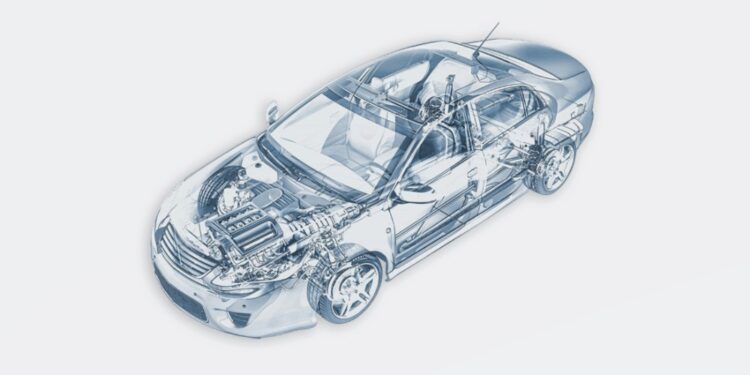The transmission system is one of the most basic and important parts of a vehicle. You can define it like this, it transfers power from the engine to the wheels. Transmission simply refers to the gearbox, which uses gears and gear trains to provide speed and torque. It is one of the most complex components of your vehicle consisting of a series of gears (gearbox).
It is primarily responsible for making sure the wheels get the right amount of power so that they can operate at a certain speed. There are many types of car transmissions. The most common are automatic, while manual transmissions in stick-shift cars require the driver to complete additional steps to effectively operate the vehicle.
How transmission system works?
The working of the transmission system varies depending on the type of transmission. Typically, the transmission system allows the gear ratio between the drive wheels and the engine. It can be adjusted as the car slows down and increases speed. Once you start your car and reach your destination, now you have to stop, in this scenario, the transmission disconnects the engine from the drive wheels so that the engine can remain idling when the wheels are not in motion. The transmission can also provide more responsive acceleration from a stop and enables the engine to run more slowly while the vehicle is running at a normal speed.
Types of vehicle transmission systems
Following are the types of transmission used in automobile vehicles:
- Manual Transmission (MT)
- Intelligent Manual Transmission (IMT)
- Automated Manual Transmission (AMT)
- Automatic Transmission (AT)
- Continuously Variable Transmission (CVT)
- Semi-automatic Transmission (SAT)
- Dual-clutch Transmission (DCT)
- Sequential Transmission (ST)
- Torque Converter Transmission (TCT)
- Tiptronic Transmission (TT)
1. Manual Transmission (MT)
A manual transmission is a system that requires the driver to manually select a gear by operating a gear stick and clutch to change gears. This transmission system is consists of a set of gears (different sizes) along with a pair of shafts. The input shaft is connected to the engine and the output shaft is continuously coupled to the input shaft and consists of several gears. In this, the driver has to select gears manually and engage or disengage the clutch pedal.
This transmission uses a flywheel, pressure plate, and clutch to engage and disengage the engine from the transmission. The flywheel and pressure plate are attached to the engine and the clutch is mounted between them. The word push in clutch means to release the pressure plate which detaches the clutch from the engine every time you do a shift, you have to push in the clutch first.
Advantages of MT
- Manual transmission is considered better for off-road purposes.
- This type of transmission system provides high torque load.
- These are much more reliable and easier to service than other types.
Disadvantages of MT
- Not everyone can drive.
- Higher learning curve.
- They require more work during driving.
2. Intelligent Manual Transmission (IMT)
Simply and quite accurately put the IMT is a clutchless manual transmission. It is similar to a manual gearbox, it has gears and a gear lever. The driver almost feels like an automatic car as the IMT doesn’t have a clutch pedal, but just a brake and an accelerator pedal. In situations like downhill or overtaking, you have complete control over the gearbox and that is certainly without the headache of operating the clutch pedal.
In this types of transmission system, you don’t need to lift the accelerator while shifting gears, if you do, it will help things run smoothly. The IMT transmission system cannot automatically shift gears. On the other hand with an IMT car compared to a manual transmission car, fuel efficiency and mileage are subjective and dependent on the driving style of the driver.
Advantages of IMT
- By using IMT Car, you can have complete control over what gear your car is in and you won’t have to rely on software.
- The cost of an IMT is also closer to that of a regular manual transmission.
- With IMT, the driver gets relief from a clutch operation, especially in city stop-go traffic.
Disadvantages of IMT
- In IMT, gear shifts are not smooth as the system relies on a clutch which has to be modulated by an actuator.
3. Automated Manual Transmission (AMT)
An automated manual transmission is an enhanced or modified version of manual transmission that has eliminated the need to engage the clutch pedal when shifting gears. It is almost similar to a manual transmission but in this system, the sensors and actuators act as clutch and shift gears. A car with an AMT does not have a clutch pedal, instead, only the accelerator and brake pedal.
This transmission also allows manual gear shift when needed. The AMT transmission uses hydraulics and a computer connected to the car’s Electronic Control Unit (ECU). The gear shift patterns are pre-programmed on this unit and work mainly on the preset RPM range. Once the system calculates maximum RPMs the ECU engages the actuators which operate the clutch and gearbox.
Advantages of AMT
- A significant advantage of the AMT over the manual transmission is its convenience because operating the clutch is not part of the diver’s task, so it reduces fatigue.
- AMT is more fuel-efficient, thus allowing more energy to flow to the wheels than automatic transmission.
- You can drive it however you want, which means most AMT equipped cars also come with the manual mode.
Disadvantages of AMT
- However, since AMTs depend on predetermined RPM levels, they can cause unplanned changes during overtaking which can be troublesome.
- Higher space requirement and more weight than a manual transmission.
4. Automatic Transmission (AT)
It is a multi-speed transmission utilized in vehicles that do not require any driver to change forward gears under normal driving situations. It is consists of a planetary gearset, hydraulic controls, and a torque converter. The engine is connected to a torque converter which is then connected to a gear system and then to the transmission. Inside the torque converter, some parts work in tandem with each other.
The outermost part houses the flywheel which spins the whole structure. The rotation pushes the fluid out of the pump at high speed, causing the turbine to spin. The fluid continues to circulate in the two sections separately and through the stator. The turbine is connected to the shaft which connects to the rest of the system and then energy is transferred to the gear system.
Advantages of AT
- The main advantage of automatic transmissions is that they are simply convenient and easy to use.
- They provide comfortable driving for the driver and passengers.
- ATs naturally have more power than any equivalent manual transmission.
Disadvantages of AT
- It is a complex system where many different items can fail.
- Very expensive to main and repair compared to manual transmission.
5. Continuously Variable Transmission (CVT)
These are pulley-based transmissions primarily used in small vehicles with smaller engines and they can change gears seamlessly through a constant gear ratio. This is in opposition to other transmissions that offer a limited number of gear ratios in fixed stages. The CVT uses two pulleys between which a steel belt runs.
To continuously change its gear ratio, the CVT simultaneously adjusts the diameter of the “drive pulley” which transmits torque from the engine, and the “drive pulley” which transfers torque to the wheels. The width of these pulleys changes depending on the power required as one gets bigger and the other gets smaller. Hence this allows delivering strong and smooth acceleration.
Advantages of CVT
- They can provide you a smoothest ride because it eliminates feeling of shifting.
- It has greater fuel efficiency because engine is always running efficiently.
- It can give you a faster response to a change in driving conditions.
Disadvantages of CVT
- They are considered unusable in off-road conditions.
- There is no engine braking capability as seen in the manual transmission.
6. Semi-automatic Transmission (SAT)
A semi-automatic transmission is a multi-speed transmission, where part of its operation is automatic, but requires a driver’s input to drive the vehicle from stop and change gears manually. It is a combination of manual and automatic transmission. It can also provide you with how to control the gears as there is a selection of both manual and automatic options.
The kinetic energy produced by the engine helps the wheels spin, while gear ratios control how fast or slow your wheels spin. Importantly, semi-automatics do not have a clutch pedal. Instead, the car’s CPU and sensors operate the clutch when the driver changes gears, as a result, semi-autos are actually easier to drive.
Advantages of SAT
- They can provide you a smooth shifting compared to manual transmission.
- Semi-automatic transmission has fewer inefficiencies in shifting means no lag time or slippage.
- You can do gear shifting quickly without any difficulty.
Disadvantages of SAT
- These are complex systems which means that objects are likely to fail.
- These types of transmission system are expensive to maintain compared to manual transmission.
- Very expensive to repair often it’s more cost-effective to just replace.
7. Dual-clutch Transmission (DCT)
This transmission employs two separate clutches for odd and even gear sets which allow for especially quick shifts. The design is often similar to two separate manual transmissions, in that their respective clutches are within a housing, and operate as a single unit. The DCT operates like an automatic transmission, requiring no driver input to change gears. This type of transmission can generally be operated in fully automatic mode or can be moved manually with the pedals on the steering wheel. These gearboxes are mainly found on race cars and high-end sports cars and they are quite expensive.
Advantages of DCT
- DCTs offer better fuel economy and better performance than automatic transmissions.
- Since they shift smoothly and with a high degree of accuracy, they are often preferred in the field of performance driving.
Disadvantages of DCT
- They are expensive, this disadvantage is compounded by their complexity which leads to more frequent and costly repairs.
- When driving at low speeds, such as in a parking lot or on the opposite side of the car, it tends to pull and lock.
8. Sequential Transmission (ST)
A sequential manual transmission allows you to select either the next gear (e.g., shifting from first gear to second gear) or the previous gear (e.g., shifting from third gear to second gear), operated through electronic pedals mounted on the rear of the steering wheel. In the vehicle with a sequential gearbox, you simply hit a lever or pedal to click through each gear, whether you’re up-shifting or down-shifting.
In some vehicles, there is an actual lever that the driver either pushes forward or pulls backward to shift up or down. Generally, it is a type of non-synchronous manual transmission used mostly for motorcycles and racing cars. They are also known as sequential gearboxes or sequential transmissions.
Advantages of ST
- Shifting gears in sequential transmission is easier.
- You can increase or decrease your speed without stopping or experiencing a drop in speed.
- This mechanism is named because you can only change gears in sequence.
Disadvantages of ST
- One disadvantage of a sequential gearbox is that you cannot “skip the shift” – i.e., change gears non-sequentially.
- Going again after a panic stop can be a bit difficult as they do not like to shift easily while stopping.
9. Torque Converter Transmission (TCT)
Torque converter transmission is one of the oldest types of automatic transmission. The first torque converters weren’t designed for any sort of performance or fuel efficiency. But today’s torque converters are quite responsive and are suitable for city or highway driving. The casing attaches to the flywheel, rotating at the same speed as the crankshaft within the turbine’s housing. Finally, the impeller or centrifugal pump drives transmission fluid to the turbine fins which in turn spins or transmits torque to the transmission. The torque converter is used in the vehicle which is provided with automatic transmission.
Advantages of TCT
- It produces maximum torque as compared to a vehicle equipped with a clutch.
- It can provide driving comfort to drivers by avoiding changing gears manually.
- They remove the clutch pedal and make driving easier.
Disadvantages of TCT
- The torque converter transmission are less fuel efficient compared to manual transmission or CVT.
- These types of transmission system require higher cost to install.
10. Tiptronic Transmission (TT)
The tiptronic transmission system is similar to an automatic transmission in that the driver can exit “automatic mode” and use the paddles to shift up or down like a manual transmission. The tiptronic transmission is also known as sportmatic or steptronic transmission. It is an automatic gearbox with the ability to change gears manually.
A tiptronic transmission works in the same way as a manual gearbox, but without the clutch. This allows you more control gears, which is ideal for going high hills or for better control when overtaking on the highway. There are safety measures built into the Tiptronic transmission that will automatically shift in case the driver forgets.
Advantages of TT
- Driving a car with a tiptronic transmission allows you more control when you change gears.
- When driving up or down a steep hill, you can manually change gears to allow for a smoother and safer ride.
- Automatic shifting in manual mode also assists the driver by delaying the engine in case of down-shift failure.
Disadvantages of TT
- The tiptronic system uses a torque converter instead of the regular clutch mechanism, this can result in some degree of power loss.
- Since in manual mode, the ECU shifts gears, there is a slight delay during the shift, which becomes evident in more aggressive driving.
Wrapping up
The function of any transmission is to transfer engine power to the driveshaft and a differential to turn the wheels. When buying a vehicle, knowing about the different types of transmission systems can help you to choose as your comfort of driving.















